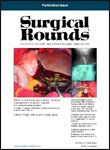Publication
Article
Surgical Rounds®
Based on its location, what type of glomus tumor is being featured?
Maria Flynn, MD
Suffolk Radiology Associates
Suffolk, VA
Sean F. Cowley, MD
MS-IV
New York College of Osteopathic Medicine
Long Island, NY
Case report
A 45-year-old man presented with an asymptomatic lateral neck mass. Physical examination and routine laboratory analysis were unremarkable. A contrast-enhanced computed tomography scan showed a glomus tumor (Figures 1 and 2).
Challenge: Based on its location, what type of glomus tumor is being featured?
- Glomus jugulare
- Glomus tympanicum
- Glomus vagale
- Carotid body tumor
Figure 1
Figure 2
Show Answer.
Answer: d. Carotid body tumor
Carotid body tumors are a subset of glomus tumors of the head and neck. Glomus tumors are relatively rare paragangliomas that are divided into types based on location. The 4 primary types within the head and neck include: glomus jugulare tumors, which are located in adventitia of the jugular bulb; glomus tympanicum tumors, which arise from the glomus bodies that run along the tympanic branch of the glossophyngeal nerve in the middle ear cavity; glomus vagale tumors, which are located infratemporally along the route of the cervical vagus nerve; and carotid body glomus tumors, which are located at the carotid bifurcation and derived from the carotid body.1
The carotid body is located in the adventitia of the carotid bifurcation. It helps maintain cardiopulmonary and blood temperature by detecting changes in arterial oxygen partial pressure and carbon dioxide and pH levels.1-3 Glomus tumors are thought to occur from an overreaction to an alteration in body homeostasis, such as occur during states of chronic oxygen deprivation.1 Long-term exposure to high altitudes has correlated with an increased risk of carotid body tumors.1 Current studies are investigating whether smoking and long-term anorexia also contribute to the formation of these tumors.1
Overall, glomus tumors represent 0.6% of tumors of the head and neck and 0.03% of all tumors.1 The frequency of malignancy within carotid body tumors is widely disputed in the literature, ranging from 2% to 30%; however, most literature reports a 10% malignancy rate.2-4
Patients with carotid body tumors are largely asymptomatic and describe a mobile, painless, slow-growing lateral neck mass anterior to the sternocleidomastoid muscle.1-3 Some patients report hoarseness, dysphagia, odynophagia, or other cranial nerve defects secondary to the close approximation with cranial nerves X to XII.2,3 Approximately 3% of patients may have symptoms associated with catecholamine production, such as fluctuating hypertension, headaches, tachycardia, and palpitations.4 The incidence of carotid body tumors peaks in patients between the ages of 45 and 50 years.1 There is a 10% to 17% incidence of bilateral involvement and multiplicity with familial cases.2-5
lyre sign
Radiographically, the gold standard for diagnosing carotid body tumors is a carotid angiogram. Angiography demonstrates a well-defined lesion with splaying of the carotid bifurcation and a characteristic tumor blush, known as .2 Not only can this modality establish the diagnosis, but it can also show if multiple lesions are present and demonstrate tumor size, vascularity, and blood supply (usually from the external carotid artery).1,2 Additionally, angiography has been used for preoperative embolization to help improve surgical outcomes.1,2,6 Computed tomography, magnetic resonance imaging, and ultrasonography are noninvasive modalities that also have a high degree of accuracy in visualizing carotid body tumors; all of these modalities would demonstrate a highly vascular mass at the carotid bifurcation.1,3,7 The treatment of choice for carotid body tumors is surgical excision.1-4
References
- Koenigsberg RA, Dastur C, Kim R. Glomus tumor (head and neck). Available at: http://www.emedicine.com/RADIO/topic309.htm. Accessed November 29, 2007.
- Davidovic LB, Djukic VB, Vasic DM, et al. Diagnosis and treatment of carotid body paraganglioma: 21 years of experience at a clinical center of Serbia. World J Surg Oncol. 2005;3(1):10.
- Zheng JW, Zhu HG, Yuan RT, et al. Recurrent malignant carotid body tumor: report of one case and review of the literature. Chin Med J (Engl). 2005;118(22):1929-1932.
- Patetsios P, Gable DR, Garrett WV, et al. Management of carotid body paragangliomas and review of a 30-year experience. Ann Vasc Surg. 2002;16(3):331-338.
- Farr HW. Carotid body tumors: a 40-year study. CA Cancer J Clin. 1980;30(5):260-265.
- Singh D, Pinjala RK, Reddy RC, et al. Management for carotid body paragangliomas. Interact Cardiovasc Thorac Surg. 2006;5(6):692-695.
- Derchi LE, Serafini G, Rabbia C, et al. Carotid body tumors: US evaluation. Radiology. 1992;182(2):457-459.
